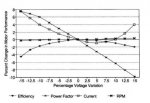In the factory test, the 460V, 60Hz, 3ph, FLA of 100A pump gives 300 litre/min. The current measured was 100A. When installed on site with a 480V, 60Hz, 3ph power supply, the pump now gives 330 litres/min and the current measured 110A.
Gievn some voltage drop across the cables which I am sure it is within 3%, shouldn't a slightly higher voltage results in a lower current drawn? Why do I measure a higher current instead?
Please let me know if you need more information. Thank you.
Gievn some voltage drop across the cables which I am sure it is within 3%, shouldn't a slightly higher voltage results in a lower current drawn? Why do I measure a higher current instead?
Please let me know if you need more information. Thank you.


